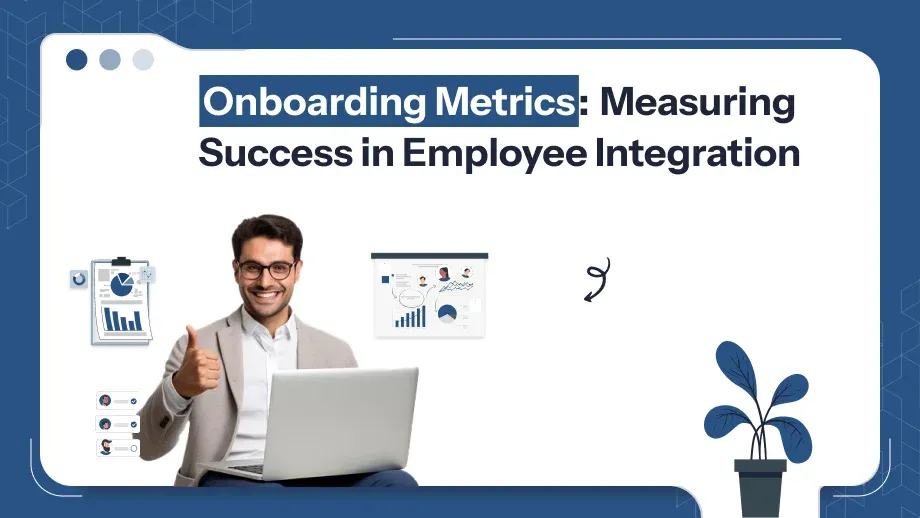
Onboarding is one of the most crucial phases in the development of employees. This creates the conditions for employees who are new and directly impacts their engagement along with retention and productivity. To ensure smooth and efficient digital employee onboarding, HR teams rely on onboarding metrics. Companies can measure the effectiveness of their strategies for onboarding as well as pinpoint the areas for enhancement.
With the help of Onboarding Analytics, HR personnel can develop strategies based on information to enhance the satisfaction of employees and also improve the company’s efficiency. This blog will focus specifically on the importance of related onboarding indicators, which are the most crucial measures to track along with how organizations improve their onboarding processes to get the most out of their efforts.
What Are Onboarding Metrics?
Onboarding metrics can be measured in a way that helps companies evaluate the efficiency and efficiency of their plans to help onboarding. The measures offer an insight into how employees are integrated into the organization the speed at which they will be able to become efficient, and also their overall satisfaction with the onboarding process.
Why Are Onboarding Metrics Important?
Improved Retention
One of the strongest reasons to keep track of onboarding statistics within HRMS payroll software in India is its impact on the retention of employees. An organized onboarding procedure creates solid foundations for new hires and helps them feel welcome and supported right from the first day. Through analyzing the performance of metrics like high turnover of new hires and retention for specific time frames Organizations can spot the problems which can lead to premature departures and adjust their onboarding processes to address the issue.
Faster Time-to-Productivity
Time-to-productivity, or the time it takes for a new hire to fully contribute to their role, is a key measure of onboarding success. This measure lets HR managers evaluate how quickly training programs are preparing participants to assume the roles they’ll be required to perform. The speedier time to productivity not only helps save money, it also means that employees feel more assured of their skills sooner. Analyzing data like the rate of training completion as well as the amount of time to get employees to reach certain goals, businesses can identify the bottlenecks within the onboarding flow metrics process.
Enhanced Employee Experience
The experience of the employee during onboarding sets the tone for their whole time with the business. Measures like employee satisfaction surveys or levels of engagement can provide useful information on how the onboarding in HRM processes meets new hires expectations. An enjoyable experience can increase the sense of engagement, and motivation as well as a feeling of community and can lead to increased performance and longer-term retention. In contrast, a badly designed onboarding process can leave employees feeling unsure and disengaged. Utilizing information, HR professionals can improve processes so that onboarding experiences are engaging, personal, and aligned to the values of the business and create a long-lasting positive impression.
Informed Decision-Making
Onboarding statistics are an essential tool to aid in the use of data to make decisions within HR. They offer quantifiable information about the efficiency of hr onboarding metric. They help HR professionals to determine what’s working and what’s not. If, for instance, show that an overwhelming number of newly hired employees leave within the first 90 days this could indicate the absence of training or a mismatch between expectations for the job and what happens.
Key Onboarding Metrics to Track
For assessing the efficacy of your program for onboarding Here are the most important employee onboarding metrics measures to concentrate on:
Employee Retention Rate
- Definition: The proportion of newly hired employees who remain in the organization over a specified period (e.g. 6 months or 1 year).
- Important: High retention rates suggest a positive employee onboarding tool because employees are reassured and engaged.
- How to Measure: RetentionRate=(Number of employees retained after X time)×100
Time-to-Productivity
- Definition: The amount of time it takes for a fresh hire to fully perform as a person in the position they are assigned to.
- Relevance: This measure measures how fast the process of onboarding gives new hires the required skills and information.
- Optimization Tips: Provide clear training schedules, assign mentors, and streamline workflows to reduce the time-to-productivity.
New Hire Turnover Rate
- Definition: The proportion of employees that leave the business within the first 90-day period or the first 6 months.
- The reason why it matters: High turnover rates highlight difficulties in the initial induction and onboarding process and onboarding processes or unmatched expectations when the hiring process.
- How to Address: Use exit interviews to identify reasons for early exits and refine your onboarding program accordingly.
Struggling to make onboarding seamless?
Leverage the power of onboarding metrics to improve retention and productivity.
Employee Satisfaction with Onboarding
- Definition: The level of satisfaction new hires feel regarding the onboarding experience.
- How to Measure: Conduct anonymous surveys with questions like:
- Did your onboarding experience exceed your requirements?
- Did you have the right preparation for the role you’re playing?
- Improvement Strategies: Individualize your experience onboarding and offer prompt help.
Onboarding Completion Rate
- Definition: The proportion of newly hired employees who finish all tasks onboarding within the timeframe they were given.
- The Key Insights Metric: This measurement uncovers the bottlenecks that hinder the process of getting onboard like unclear directions or inadequate processes.
- Take action: Utilize onboarding automation tools to speed up work completion.
Engagement Levels During Onboarding
- Definition: The extent to which new hires actively participate in onboarding activities, such as training sessions, workshops, and team introductions.
- Important: High levels of engagement indicate that employees are connected and driven.
- How to Track: Use attendance and feedback from onboarding activities to measure engagement.
Cost of Onboarding Per Hire
- Definition: The expense of bringing on new employees, which includes the training, materials, and instruments.
- The reason it matters: This measurement helps in optimizing budgets, and also ensures cost-effectiveness while not hindering the quality of your onboarding.
How to Collect and Analyze Onboarding Data
- Use HRMS and Onboarding Tools:
Leverage employee onboarding software for tracking onboarding requirements along with training and giving feedback on the spot.
- Conduct Surveys:
Gather feedback from the new employees and supervisors to gather quantitative insights about the experience of onboarding.
- Analyze Trends:
Use dashboards to visualize onboarding and identify patterns across departments and roles.
Best Practices for Improving Onboarding Metrics
Set Clear Goals and KPIs
- Specific targets should be set for each metric onboarding, For example, reducing productivity by 10 percent.
- Be sure to align these goals with the larger goals of the organization.
Personalize the Onboarding Experience
- Tailor onboarding programs to individual roles and departments.
- Implement pre-onboarding measures to get employees for their onboarding date.
Automate Onboarding Processes
- Use preboarding software automation to streamline repetitive tasks like document submission and training schedules.
- Automate the reminders of tasks that are not completed to make sure that the task is completed on time.
Provide Ongoing Support
- Affect mentors or other friends to assist new employees in their first few weeks.
- Offer continuous learning opportunities to foster skill development.
Gather Continuous Feedback
- Establish a feedback loop in which newly hired employees can share their experiences and improvements they would like to see.
- Regularly update the onboarding program based on feedback.
Challenges in Measuring Onboarding Metrics
- Data Accuracy:
Uncoherent data collection techniques could lead to incorrect insights. Use reliable tools to ensure precision.
- Stakeholder Buy-In:
Resistance from managers or teams can hinder the effective implementation of onboarding metrics. Communicate the value of these metrics to all stakeholders.
- Overwhelming Data:
Avoid focusing on too many metrics at once. Prioritize key onboarding success metrics that align with organizational goals.
Future Trends in Onboarding Metrics
- AI-Powered Insights:
Artificial Intelligence can analyze information from onboarding to forecast new hiring success, and also identify improvement points.
- Focus on Emotional Well-Being:
The monitoring of mental health metrics and the well-being of employees in digital onboarding is likely to gain significance.
- Interactive Onboarding Platforms:
Tools for onboarding that are gamified and interactive platforms increase the level of engagement and offer real-time data analytics.
Conclusion
Onboarding metrics play an important contribution to the overall success of new employees and the longevity of an organization. by tracking important measures of new employee onboarding metrics, can determine the strengths and weak points in their policies, make changes based on data, and make an easy journey for employees. Employing software like employee onboarding will ensure that the process for onboarding is efficient as well as engaging and in line with the goals of the organization.





